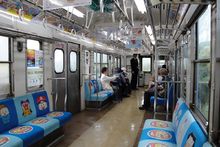- Choshi Electric Railway 1000 series
-
Choshi Electric Railway 1000 series 
DeHa 1002, January 2011In service August 1994–Present Manufacturer Hitachi, Teikoku Sharyo Replaced 100/500 series Constructed 1959–1960 Refurbishment 1994 Number in service 2 vehicles Formation Single car Fleet numbers DeHa 1001/1002 Capacity 98 (34 seated) Operator Choshi Electric Railway Depot(s) Nakanocho Specifications Car body construction Steel Car length 16,000 mm Width 2,700 mm Doors 3 pairs per side Weight 30.5 t Traction system MB-3054-AE4 (75 kW x4) Power output 300 kW Electric system(s) 600 V DC Current collection method Overhead wire Bogies Sumitomo FS-316 Gauge 1,067 mm (3 ft 6 in) The Choshi Electric Railway 1000 series (銚子電鉄1000形 Chōshi Dentetsu 1000-gata) is an electric multiple unit train type operated by the Choshi Electric Railway in Japan since 1994. The two single cars were converted from former Eidan Ginza Line (now Tokyo Metro Ginza Line) 2000 series EMU cars, which were built in 1959 and 1960, and were introduced from 29 August 1994 to replace the ageing 100 and 500 series EMU cars.[1][2]
Contents
Build details
No. Former No. Manufacturer Build date DeHa 1001 2046 Teikoku Sharyo October 1960 DeHa 1002 2040 Hitachi November 1959 Source: [1]
External livery
Both cars were initially painted in the "new" Choshi Electric Railway livery of dark brown and red. DeHa 1001 was repainted in April 2007 into a sky blue promotional livery sponsored by game manufacturer Hudson Soft in connection with the 20th anniversary of the Momotaro Dentetsu game series in 2008.[3] DeHa 1002 was repainted into a new orange and blue livery in 2007 designed by Tetsuko no Tabi writer Naoe Kikuchi intended to evoke an image of the sun rising across the sea.[1]
Interior
The trains feature longitudinal seating, and are equipped with fare collection boxes at each end for wanman driver only operation. The trains are not equipped with air-conditioning.
History
Two EMU cars were purchased from Eidan in 1994, and were modified for driver-only-operation and repainted at a cost of approximately 35 million yen per car.[4] The bogies were reclaimed from withdrawn Fuji Kyuko 5700 series (former Odakyū 2300 series) EMUs.[2]
See also
 Media related to Choshi Electric Railway 1000 series at Wikimedia Commons
Media related to Choshi Electric Railway 1000 series at Wikimedia CommonsReferences
- ^ a b c Satō, Toshio (December 2009). "銚子電鉄の電車たちを訪ねて [Visiting the trains of the Chōshi Electric Railway]" (in Japanese). Japan Railfan Magazine (Japan: Kōyūsha) 49 (584): p.92–96.
- ^ a b 年鑑'95日本の鉄道 [Yearbook 1995: Japanese Railways]. Japan: Railway Journal. April 1995. p. 66.
- ^ "「桃太郎電鉄20周年記念車両 出発式」開催 ["Momotaro Dentetsu" 20th anniversary train departure ceremony]" (in Japanese). IT Media Games. IT Media Inc.. 26 April 2007. http://gamez.itmedia.co.jp/games/articles/0704/26/news077.html. Retrieved 11 August 2010.
- ^ "銚子電鉄の電車たち vol.2 [The Trains of Choshi Electric Railway Vol. 2]" (in Japanese). Choshi Electric Railway. http://www.choshi-dentetsu.jp/denshavol2/densha2.htm. Retrieved 11 August 2010.
External links
Chōshi Electric Railway rolling stock In service 1000 series • 2000 seriesWithdrawn 100 series • 200 series • 300 series • 500 series • 700 series • 800 seriesCategories:- Electric multiple units of Japan
- 1994 introductions
Wikimedia Foundation. 2010.




